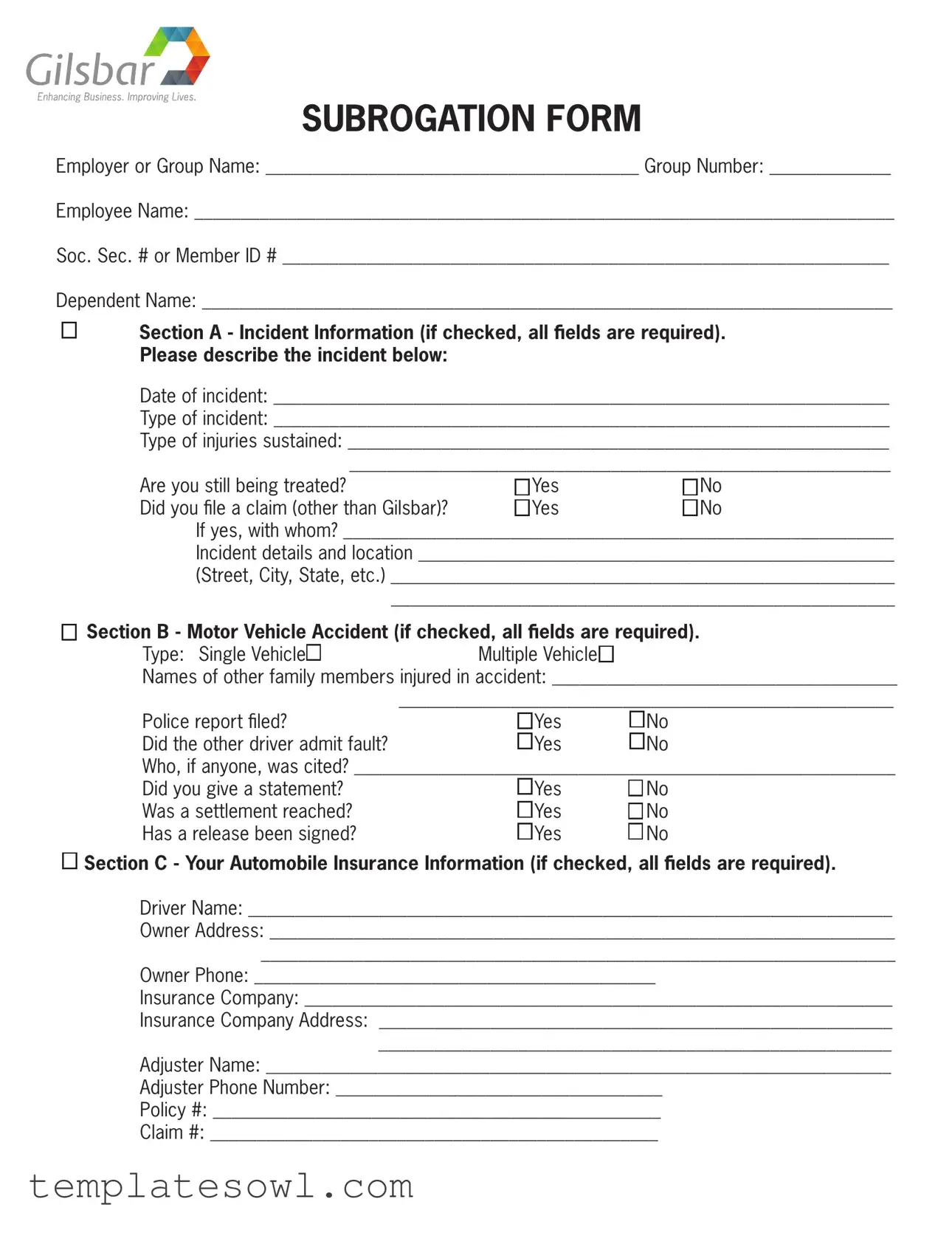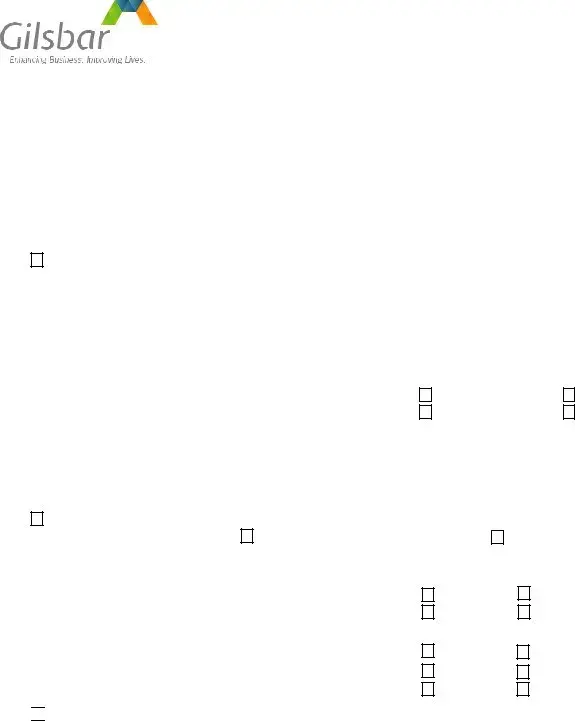Gilsbar 

Enhancing Business. Improving Lives.
Employer or Group Name: ________________________________________ Group Number: _____________
Employee Name: ___________________________________________________________________________
Soc. Sec. # or Member ID # _________________________________________________________________
Dependent Name: __________________________________________________________________________
□ |
Section A - Incident Information (if checked, all felds are required). |
|
Please describe the incident below: |
|
|
|
Date of incident: __________________________________________________________________ |
|
Type of incident: __________________________________________________________________ |
|
Type of injuries sustained: __________________________________________________________ |
|
__________________________________________________________ |
|
Are you still being treated? |
□Yes |
□No |
|
Did you fle a claim (other than Gilsbar)? |
□Yes |
□No |
|
If yes, with whom? ___________________________________________________________ |
|
Incident details and location ___________________________________________________ |
|
(Street, City, State, etc.) ______________________________________________________ |
|
______________________________________________________ |
□ |
Section B - Motor Vehicle Accident (if checked, all felds are required). |
|
Type: Single Vehicle□ |
Multiple Vehicle□ |
|
|
Names of other family members injured in accident: _____________________________________ |
|
_____________________________________________________ |
|
Police report fled? |
□Yes |
□No |
|
Did the other driver admit fault? |
□Yes |
□No |
|
Who, if anyone, was cited? __________________________________________________________ |
|
Did you give a statement? |
□Yes |
□No |
|
Was a settlement reached? |
□Yes |
□No |
|
Has a release been signed? |
□Yes |
□No |
□
 Section C - Your Automobile Insurance Information (if checked, all felds are required).
Section C - Your Automobile Insurance Information (if checked, all felds are required).
Driver Name: _____________________________________________________________________
Owner Address: ___________________________________________________________________
____________________________________________________________________
Owner Phone: ___________________________________________
Insurance Company: _______________________________________________________________
Insurance Company Address: _______________________________________________________
_______________________________________________________
Adjuster Name: ___________________________________________________________________
Adjuster Phone Number: ___________________________________
Policy #: ________________________________________________
Claim #: ________________________________________________
□
 Section D - Other Insurance Information (if checked, all felds are required).
Section D - Other Insurance Information (if checked, all felds are required).
The responsible party’s automobile insurance, the worker’s compensation insurance, or homeowner’s/liability insurance:
Name: __________________________________________________________________________
Address: _________________________________________________________________________
____________________________________________________________________
Phone: _______________________________________________
Insurance Company: _______________________________________________________________
Insurance Company Address: _______________________________________________________
_______________________________________________________
Adjuster Name: ___________________________________________________________________
Adjuster Phone Number: ___________________________________
Policy #: ________________________________________________
Claim #: ________________________________________________
□
 Section E - Attorney Information (if checked, all felds are required).
Section E - Attorney Information (if checked, all felds are required).
Attorney Name: ___________________________________________________________________
Firm Name: ______________________________________________________________________
Firm Address: ____________________________________________________________________
____________________________________________________________________
Attorney Phone Number: _______________________________________________
Attorney Fax Number: _________________________________________________
I hereby acknowledge that my medical plan has a subrogation/reimbursement agreement provision which provides that medical benefts paid under the plan on behalf of me or any person covered under my plan. I agree to reimburse (up to the amount of such benefts paid) from any payments, awards, or settlements which may be paid by a third party because of the injury described above. I authorize Gilsbar, LLC and the Phia Group to release information regarding any claims in order to directly seek and receive such reimbursement from any third party payments that may in the future, become payable because of this injury. Furthermore, I hereby authorize any medical provider, my lawyer or agent, or any other person or corporation to release any and all medical information relating to the incident to The Phia Group.
The Phia Group is the administrator who pursues subrogation and reimbursement claims on behalf of Gilsbar. Thank you for your cooperation.
I represent that, to the best of my knowledge, the information provided on this form is complete and accurate.
Signature: ____________________________________________________________________
Date: ______________________________________





 Section C - Your Automobile Insurance Information (if checked, all felds are required).
Section C - Your Automobile Insurance Information (if checked, all felds are required).

 Section D - Other Insurance Information (if checked, all felds are required).
Section D - Other Insurance Information (if checked, all felds are required).
 Section E - Attorney Information (if checked, all felds are required).
Section E - Attorney Information (if checked, all felds are required).